This winter, Cristina and I spent a crazy week at the beach in Sanibel Island, Florida. An unusual combination of events, including a huge offshore storm and a red tide, caused millions of creatures, both alive and dead, to wash up on the beach. It was unlike anything I had ever seen. The place was covered in Sanibel Island shells.
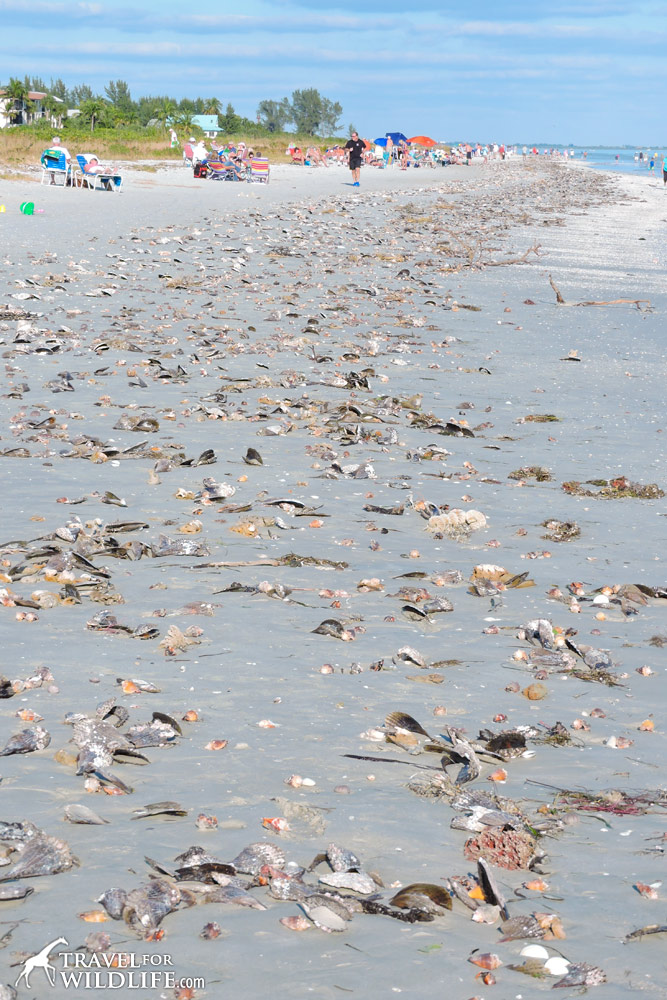
It allowed me, for the first time, to meet the living creatures behind all of Sanibel’s beautiful seashells. Did you ever wonder what lives in seashells?
During the week, we developed a Guide to Ethical Sea Shell Collecting, and after witnessing the many functions that discarded sea shells serve in the environment, we concluded that the most environmentally-friendly shell collection of all would be to collect them with my camera.
Here is my virtual shell collection, a photo gallery of some of the many beautiful sea creatures and living shells we found on Sanibel Island, Florida. Enjoy!
If you’re a shell collector, you might also enjoy our article, How to Tell if a Sand Dollar, Starfish, Egg Case, Urchin, or Sea Shell is Alive or Dead.
*This article may contain affiliate links. We receive a small commission at no extra cost to you.*
Where to Stay in Sanibel
Before you go looking for the sea shells of Sanibel you need a place to stay! We stayed for a week at the beautiful Sanibel Moorings. The apartment was excellent and the resort has a private beach access. Click here to check current prices and availability.
If you want something more like a private colorful cottage on the beach, with lots of Florida vibes, then look no further than Castaways Cottages. Ask for a cottage right on the beach or at the marina and make your dreams come true! Click here to check current prices and availability.
You can also find lots of vacation rentals in Sanibel.
Photo Gallery of Living Sea Shells of Sanibel
Long tide pools formed in the sand and strange little animals were going about their business as if they were still on the bottom of the ocean. Here are some of the “living sea shells” of Sanibel I encountered.
The Baby’s Ear shell is a popular shell with collectors. But the living animal is even more interesting. Unlike most mollusks, the living creature is so fat that it can’t pull all the way back into its shell!
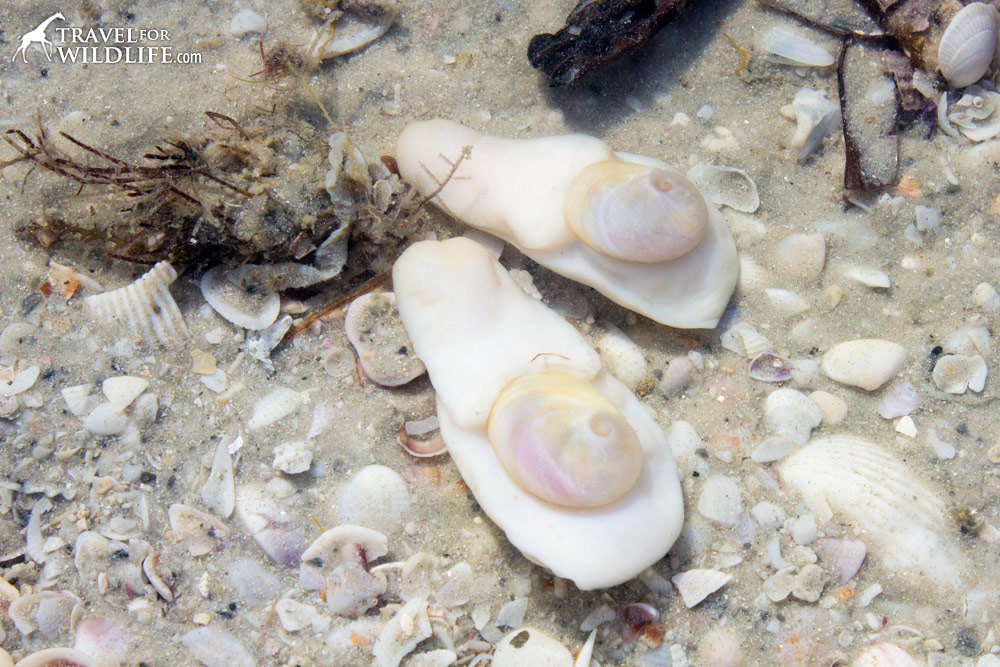
Another favorite with collectors is the humongous Horse Conch shell. These are the largest mollusks (and shells) that your are likely to find on Sanibel.
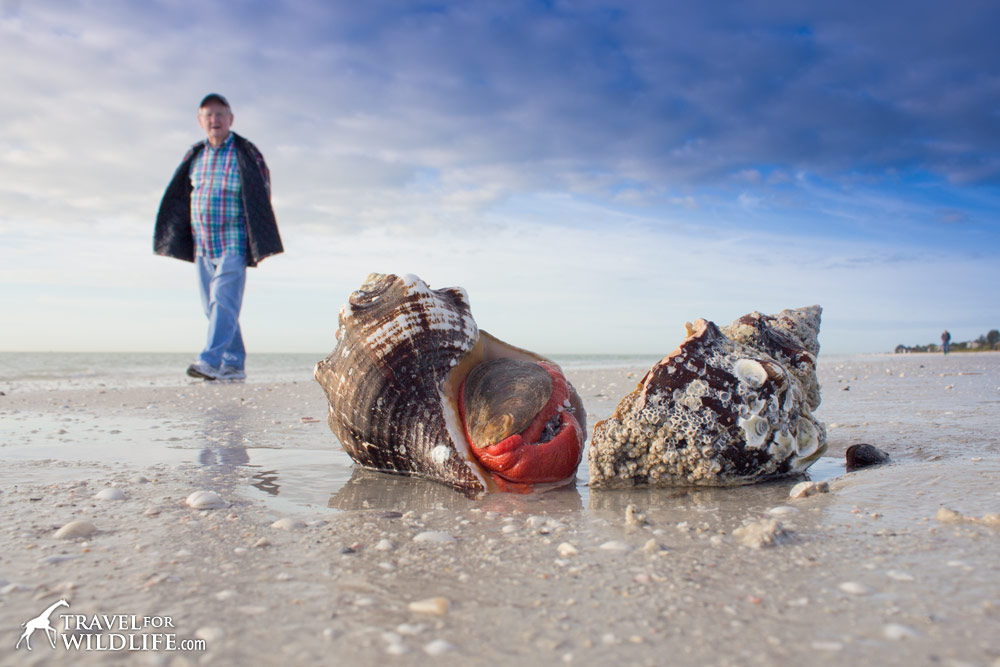
The body of a horse conch is a brilliant red-orange when alive.
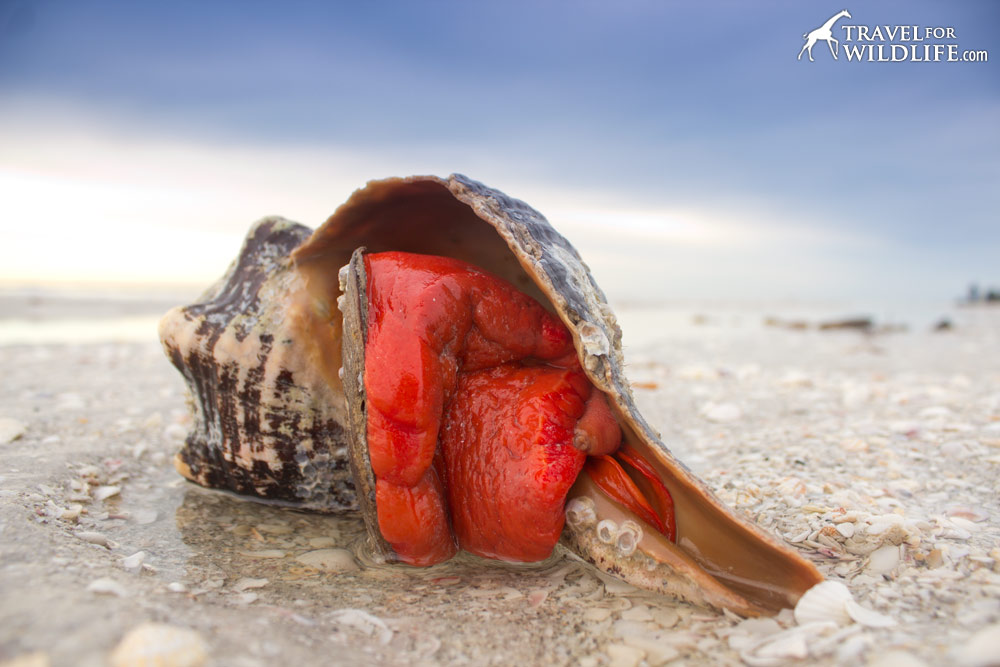
Many mollusks that live in spiral shells have what is called an “operculum” which is a hard flat piece of shell-like material attached to the bottom of the foot and is used as a little door to close themselves inside. You can see the Horse Conch’s operculum in the first photo above and it is especially visible on this large living Lightning Whelk below.
The Lightning Whelk is the only left-handed spiral shell you are ever likely to find in Florida. How to determine if a shell is left-handed or right-handed? Hold the shell with the spire pointing upward and the canal pointing downward (as in the photo below). Then imagine you are going to curl your hand into the opening. Which hand would you use? In this case, it is the left hand, making the Lightning Whelk a left-handed shell. If you ever find a left-handed shell that is not a lightning whelk, then you have discovered a truly rare oddity!
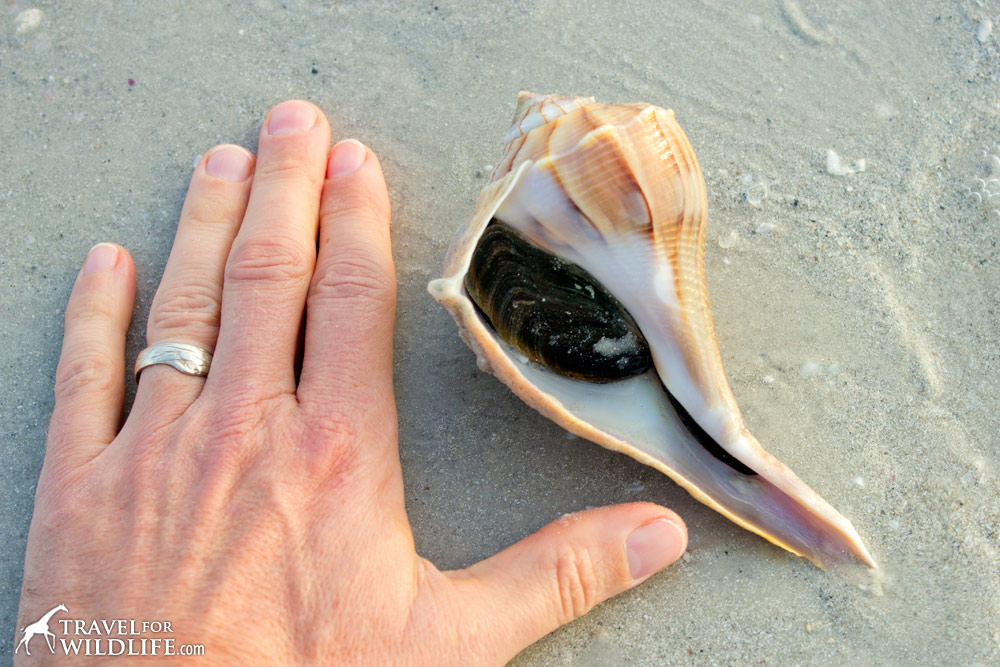
Here’s another cool shell with a a tiny little operculum tightly shut. It’s called an Apple Murex.
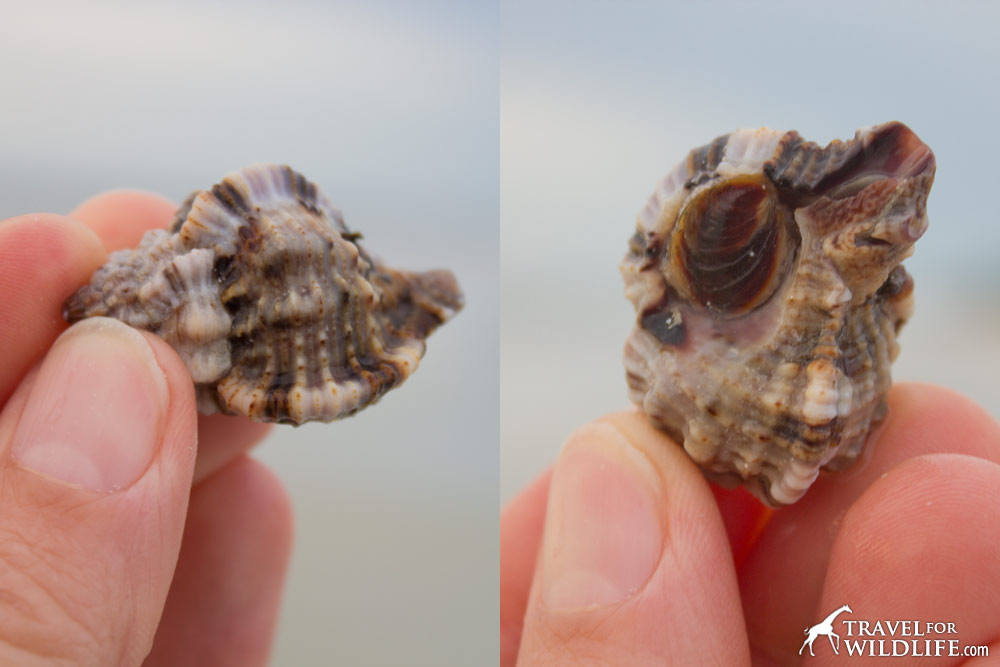
The Sharks Eye shell is another popular seashell with collectors. The living animal can inflate the size of its body using water and deflate it again to fit back inside the shell. It is a serious predator and eats many other kinds of mollusks.
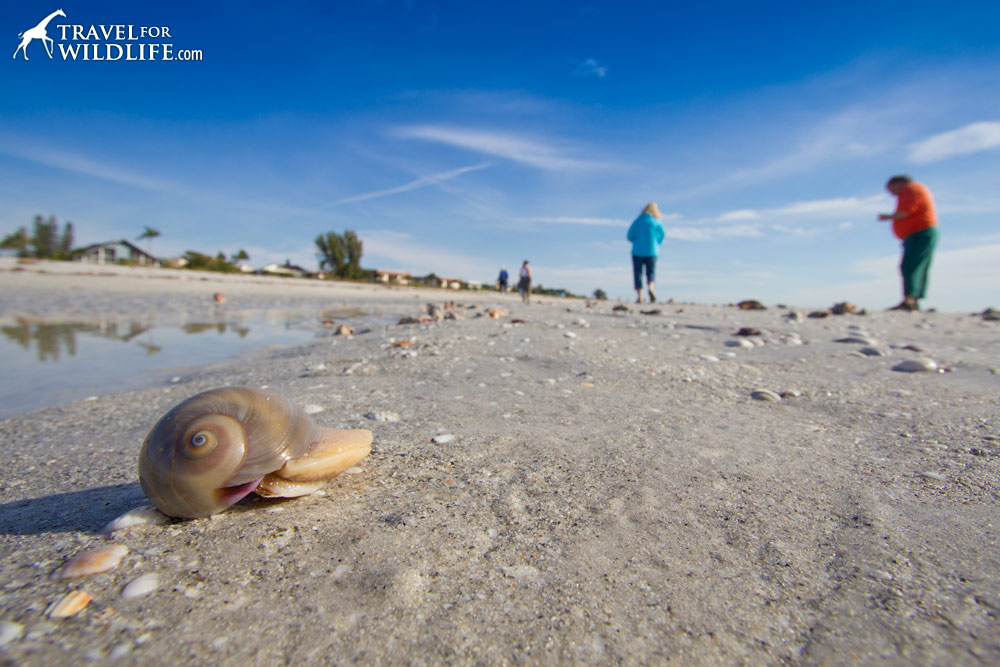
The Lettered Olive shell appears very glossy when its alive because the mantle extends around the shell. The markings on the shell are supposed to look like hand lettering.

One of the most beautiful living creatures I discovered was a True Tulip. The body of the living animal looks like a dark starry sky.
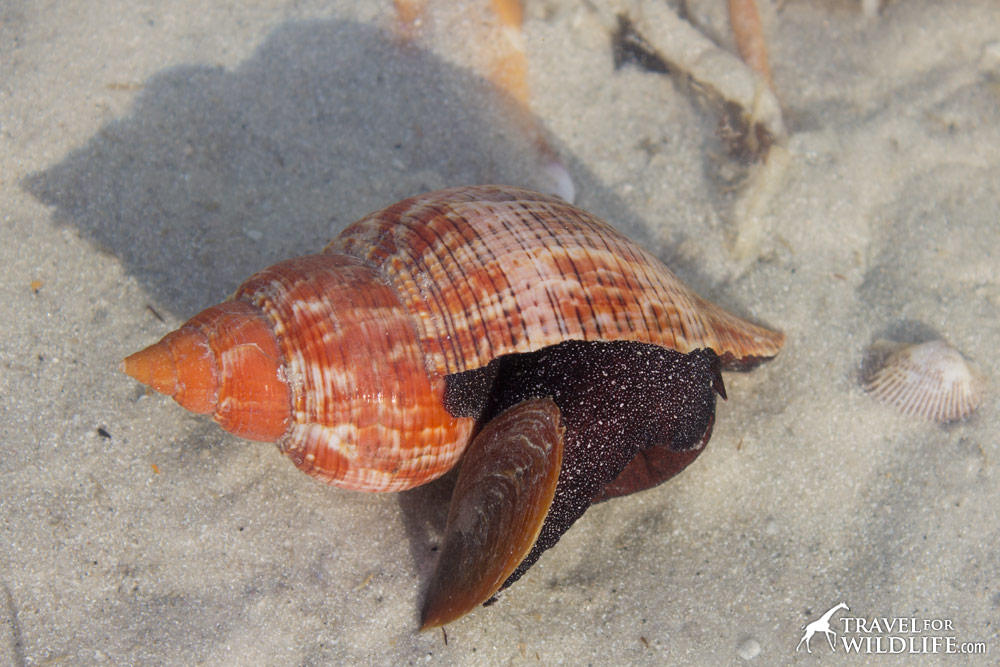
Here is another live tulip called a Banded Tulip, leaving a cool track as it moves across the sand.
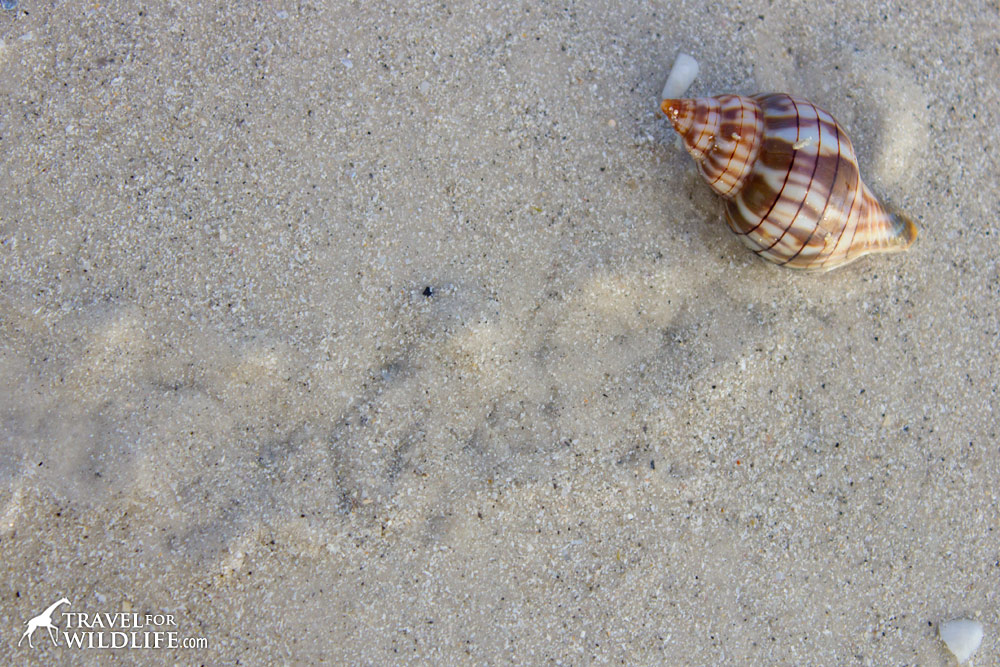
Finding an empty Spiny Jewel Box shell is pretty rare but it’s even more unusual to find a live one like this.
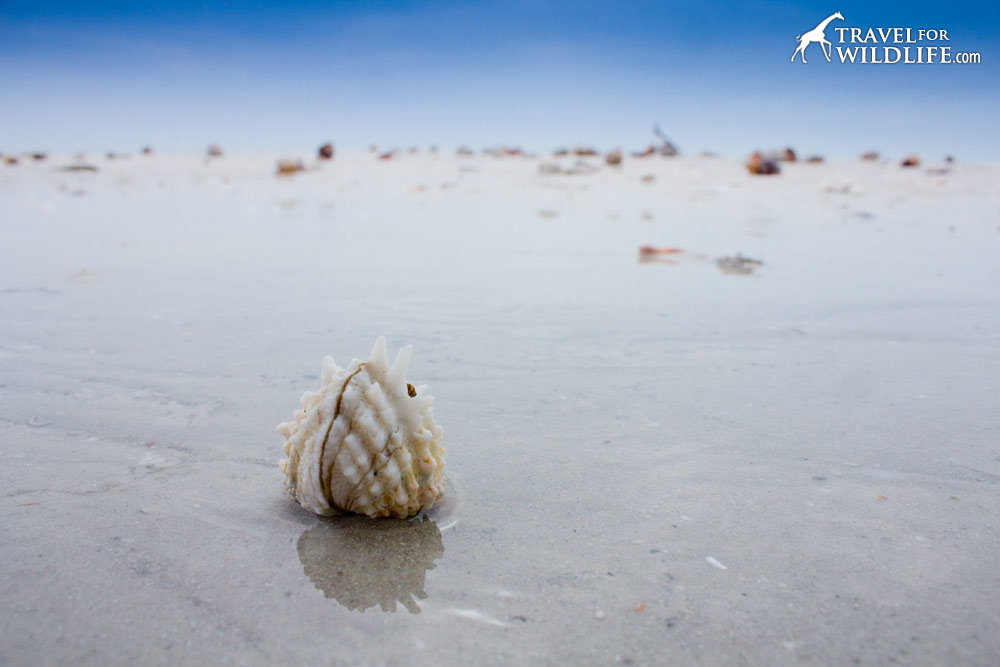
Probably the most active living shells I encountered were Figs. Almost every living Fig I saw in the shallow tide pools was twisting and stretching and displaying its fascinating anatomy. Here are couple of the more interesting poses I captured.
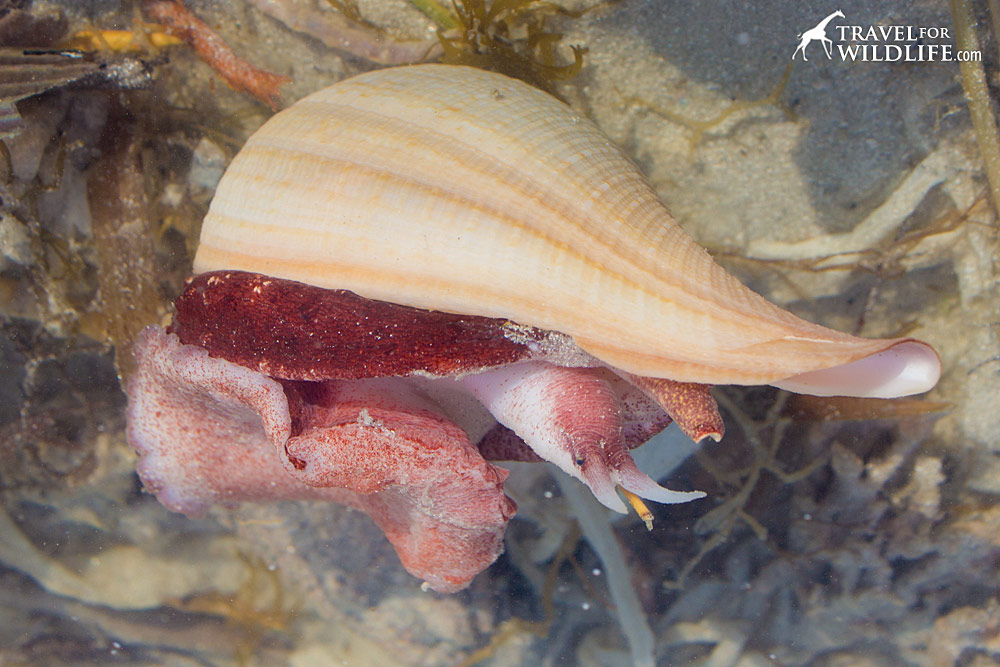
And this one was the craziest of all. As best I can tell, this Fig is a male because he is displaying his large penis!
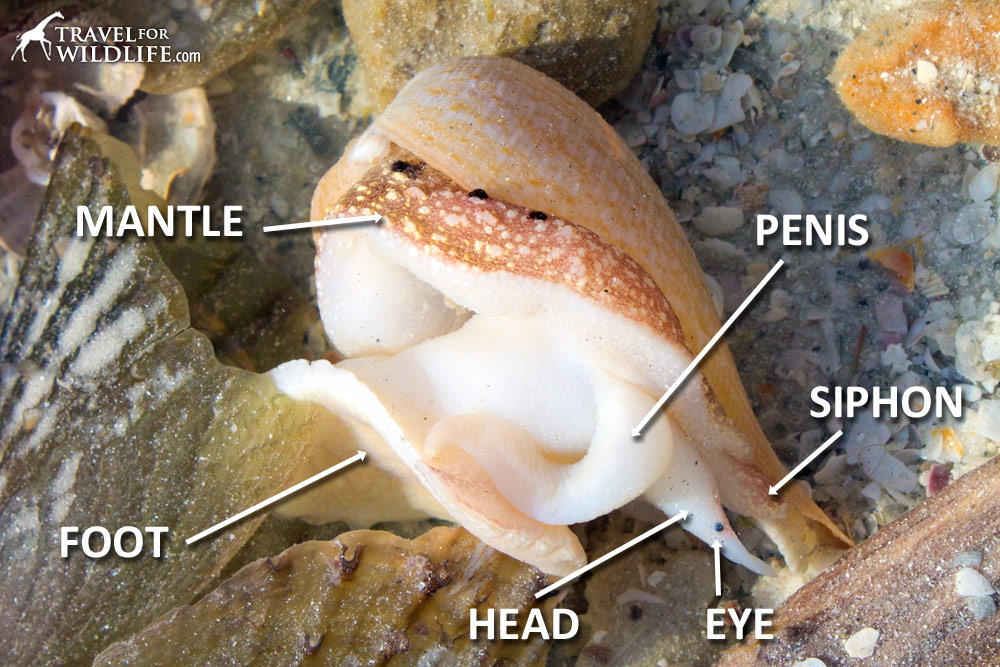
There were hundreds of huge living Cockle Shells opening and closing in the shallow water of the tide pools and siphoning food from the water.
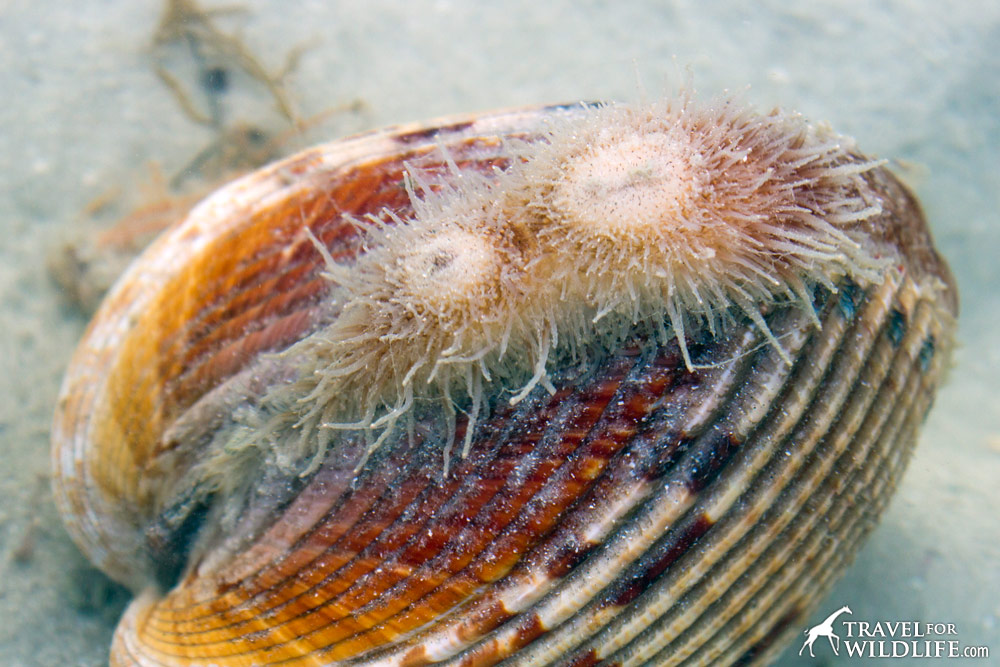
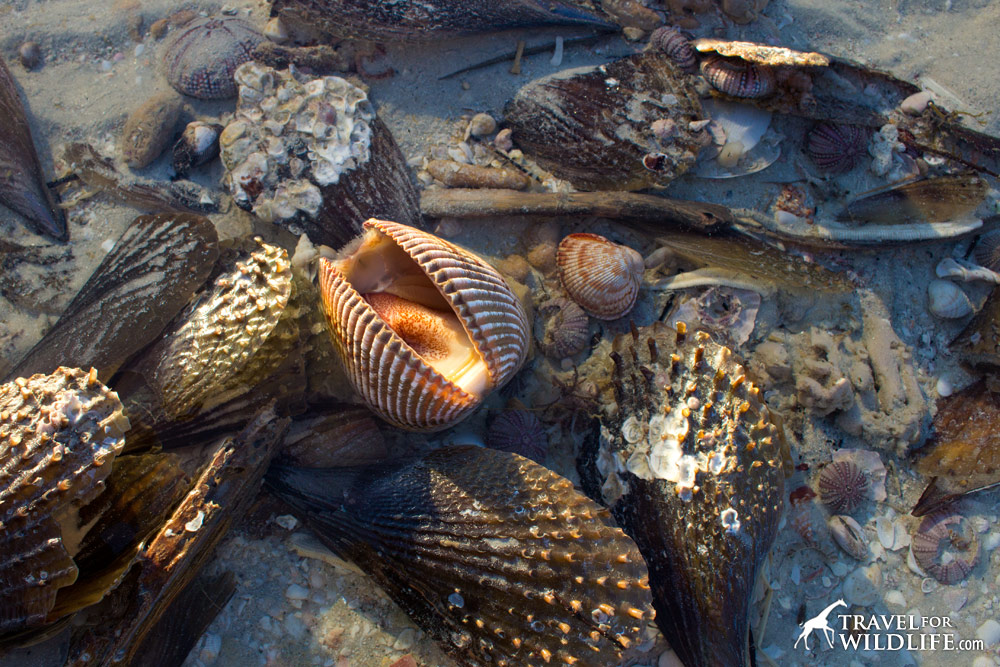
There were also lots and lots of huge fan-shaped Pen Shells washed up on the beach and I even managed to find a couple of live ones.
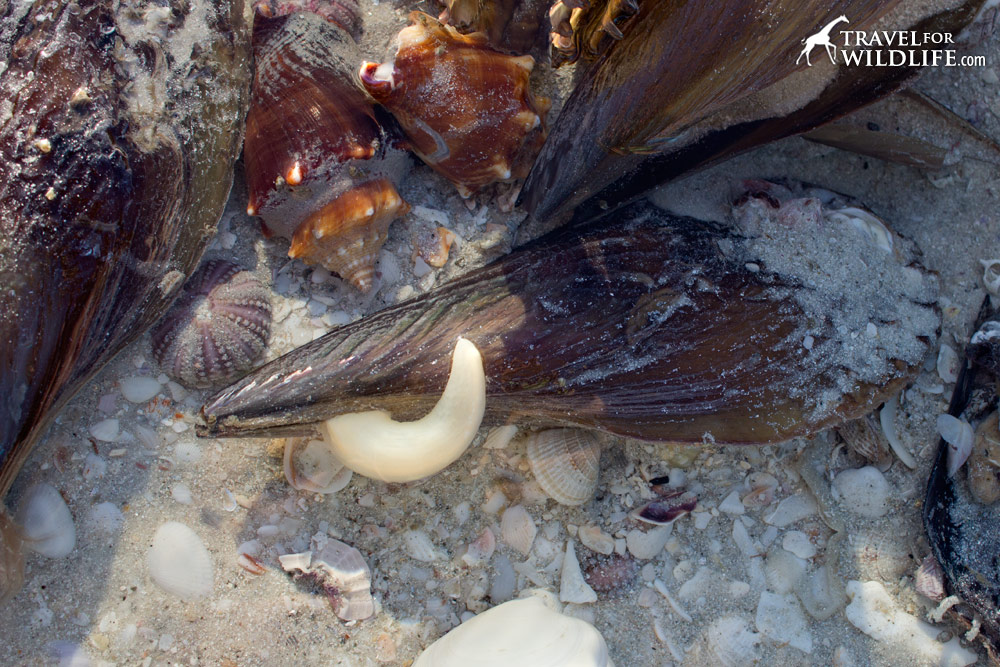
Dead Pen Shells are used by many other species of shells to anchor upon. One of the most interesting is the Slipper Shell.
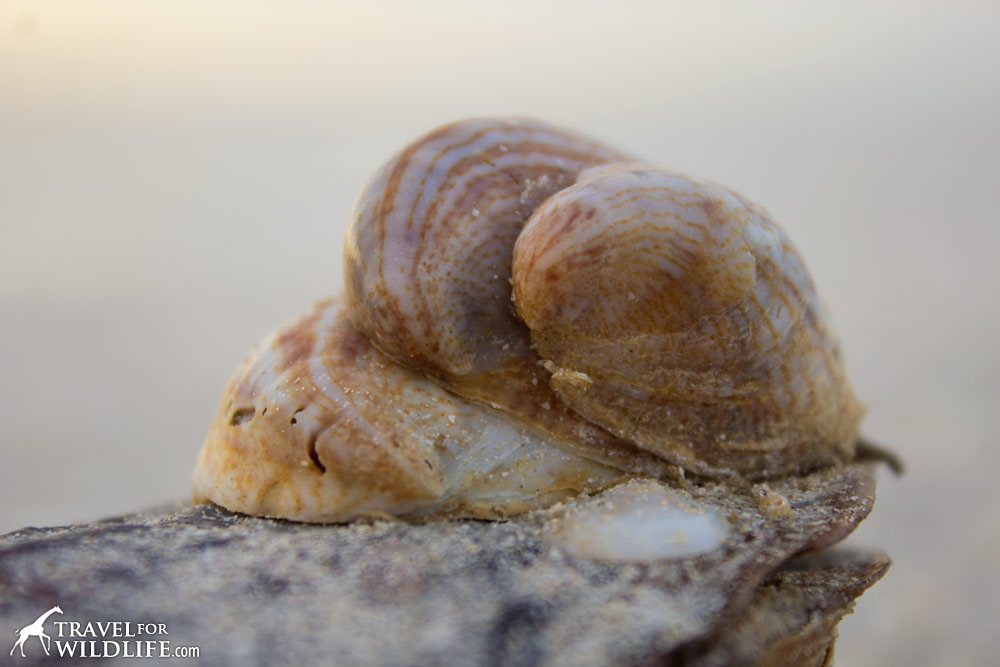
Slipper Shells pile on top of each other for mating purposes. Males stack up on top of a female and reach downward to fertilize her. But the most amazing part is that Slipper Shells can change sex. When the female at the bottom dies, the next male up will transform into a female!
Below is a stack of Slipper Shells on top of a living Ponderous Ark. The black fuzzy-looking stuff is part of the Ark’s outer layer of shell called the “periostracum”.
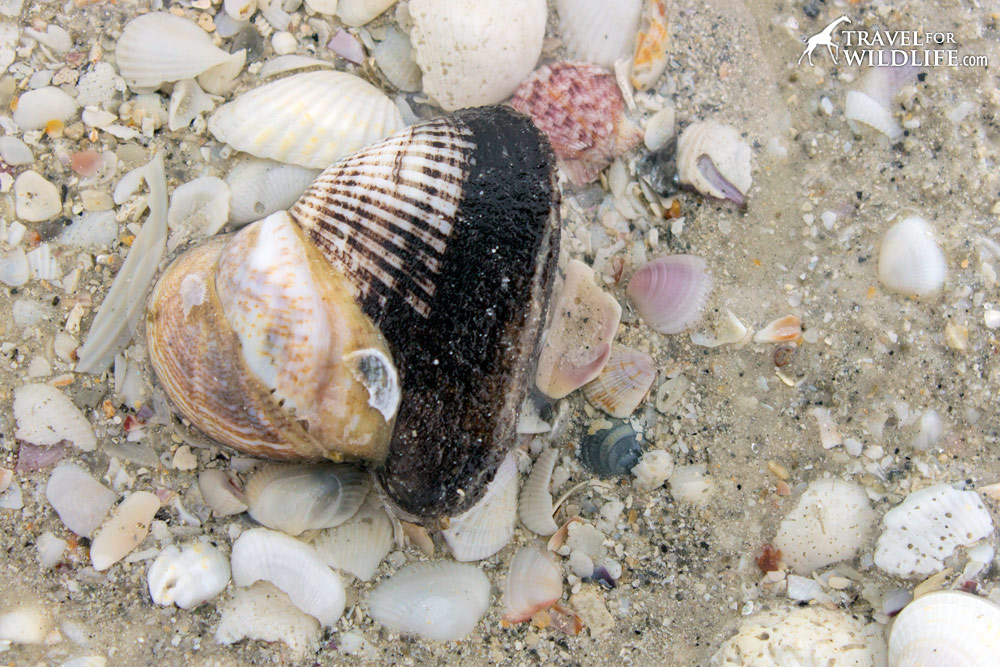
But my favorite living shell of all was the Florida Fighting Conch. If you’re still having a hard time feeling a connection to these little mollusks, just look into the eyes of this Florida Fighting Conch as she waits for the tide to rise so she can return to the sea.
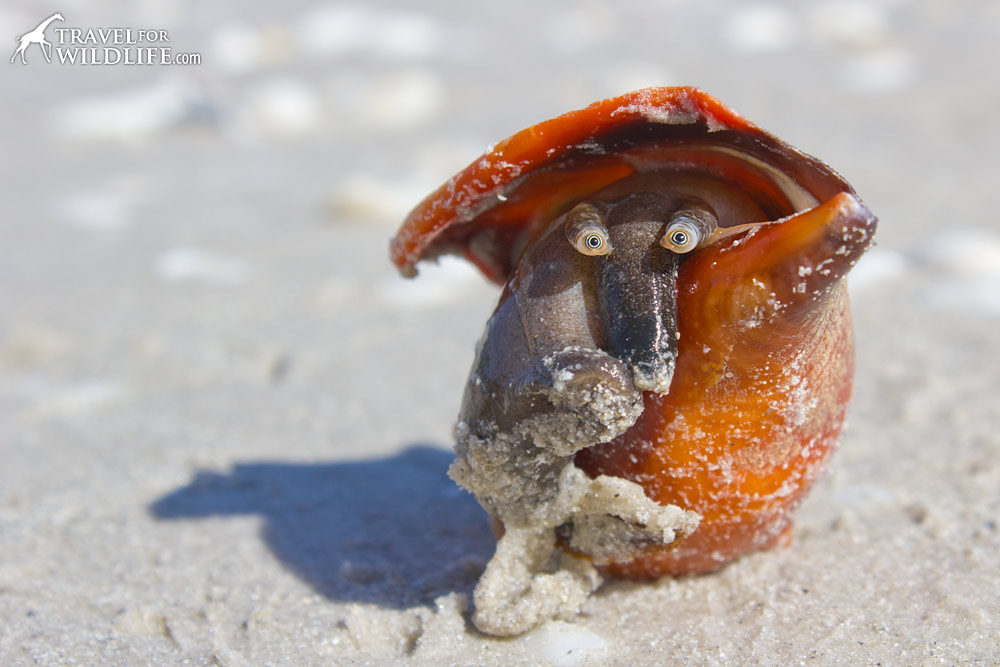
Crabs on Sanibel Island
My favorite crabs on Sanibel were the hermit crabs. We saw dozens of them, occupying spiral shells of all sizes, from tiny to gigantic. Hermit crabs require ever larger shells to move into as they grow, which is the main reason we recommend you don’t take too many spiral shells from the beach in our Guide to Ethical Shell Collecting.
This hermit crab lives in a fig shell.
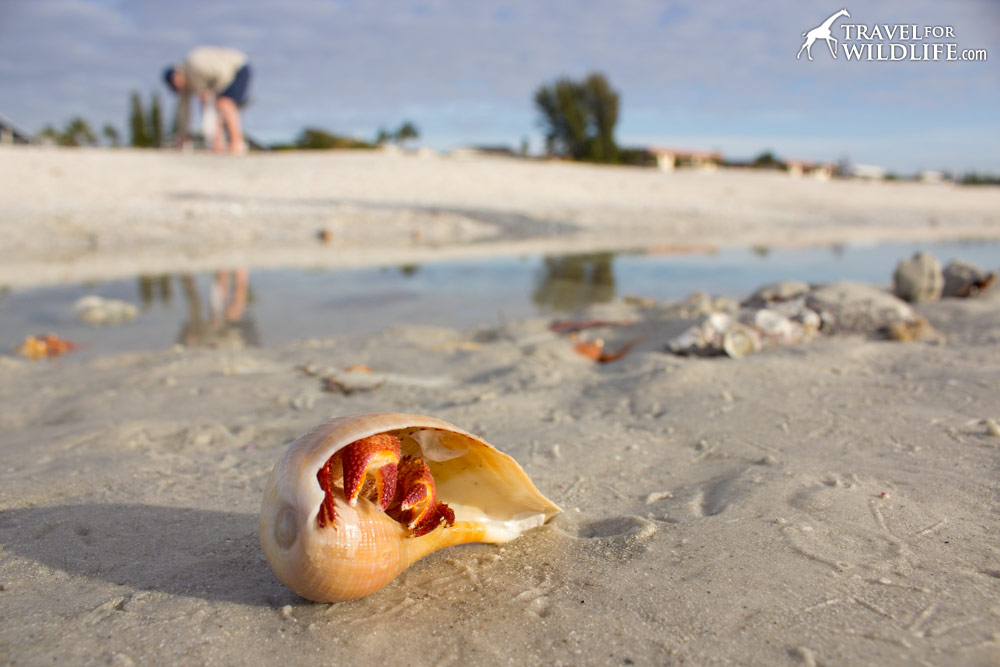
Here’s a different species of hermit crab living in a juvenile Florida Fighting Conch Shell, although the shell looks a bit too big for this little guy.
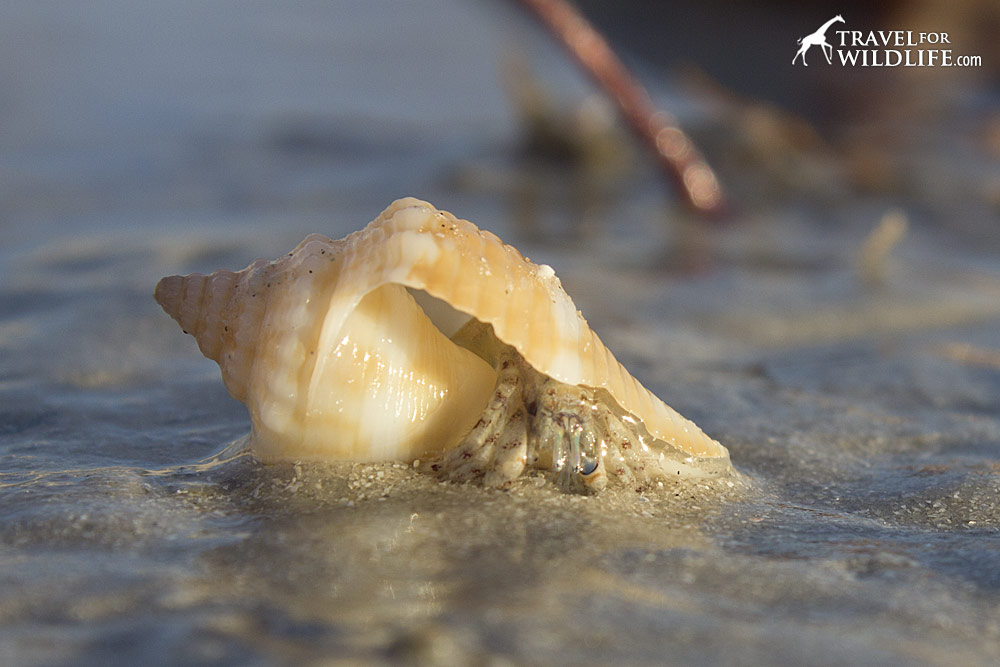
Here’s a hermit searching desperately for the right-sized shell shell to move into.
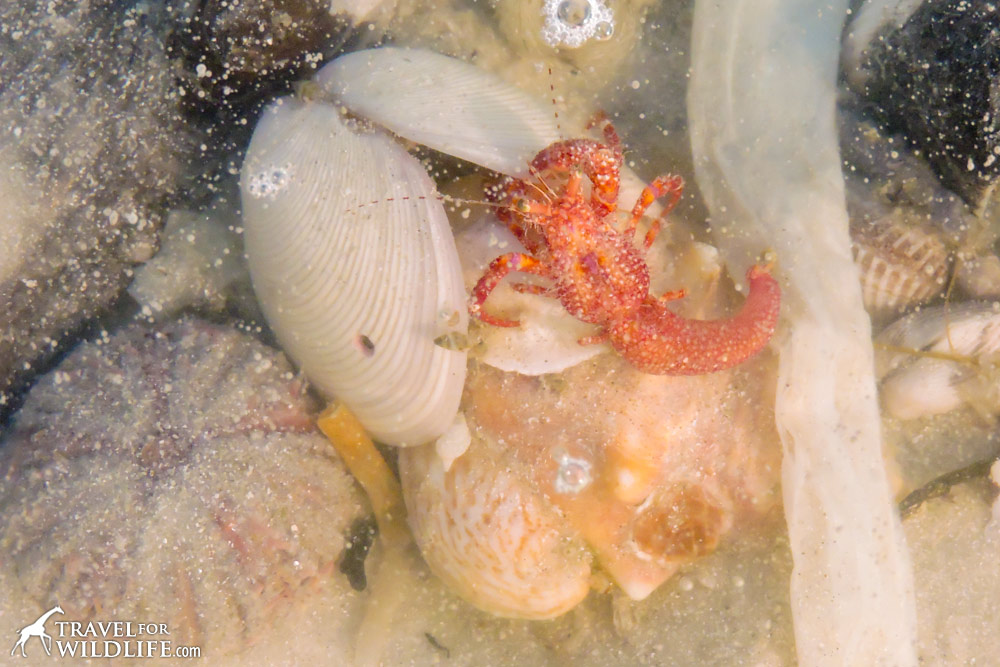
And I found this gigantic hermit crab dead on the beach. He probably couldn’t find a big enough shell to move into. Just another reason not to take all the big horse conch shells.
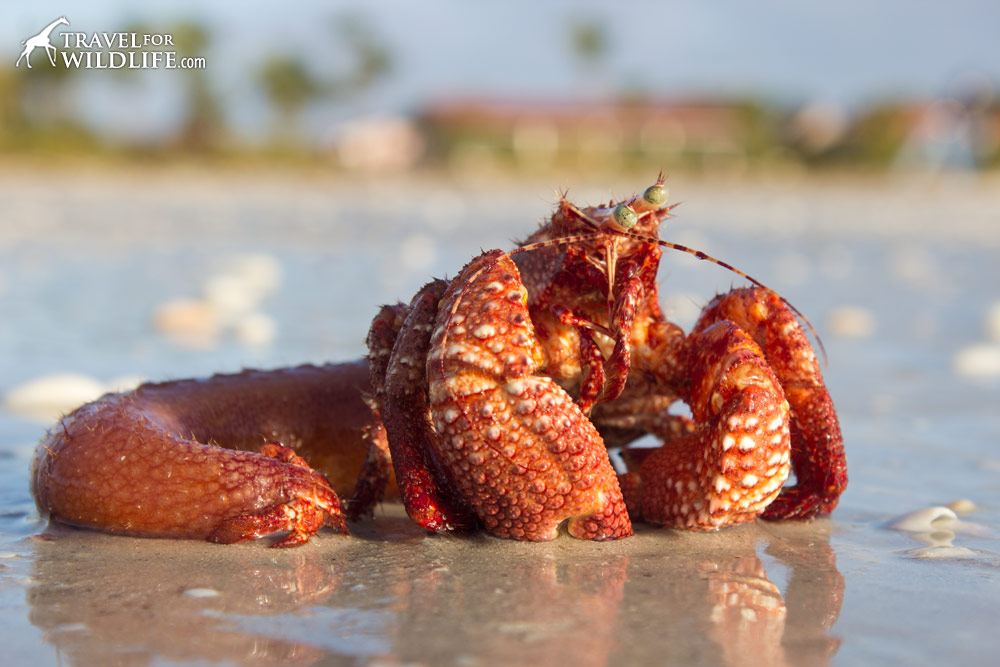
There was a wide array of other crabs on the beach as well. I spotted this beautiful calico crab in a tide pool.
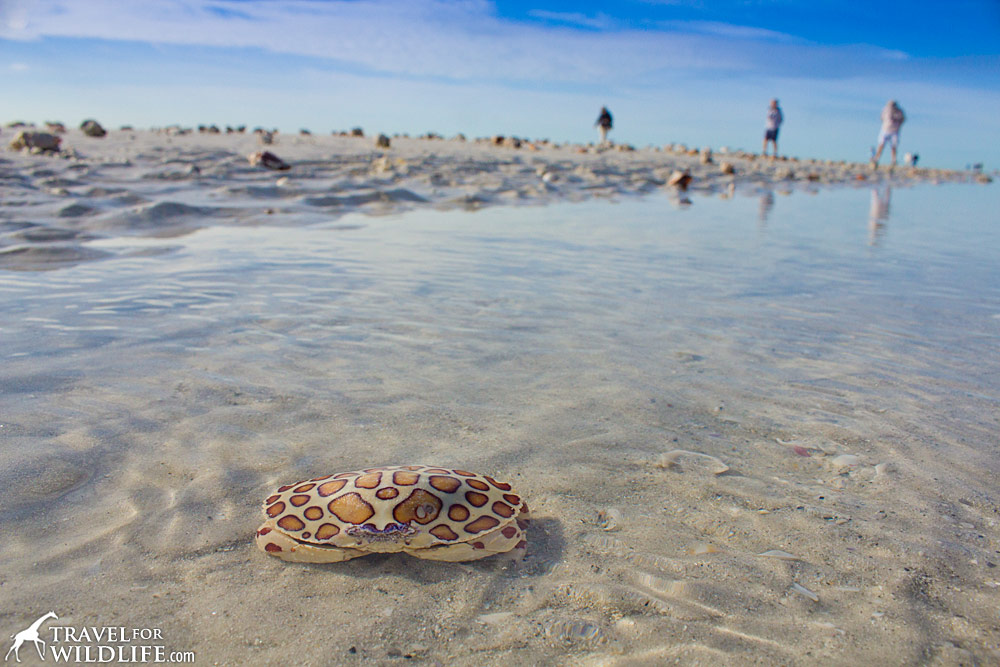
Along with a bunch of different crab species washed up dead.
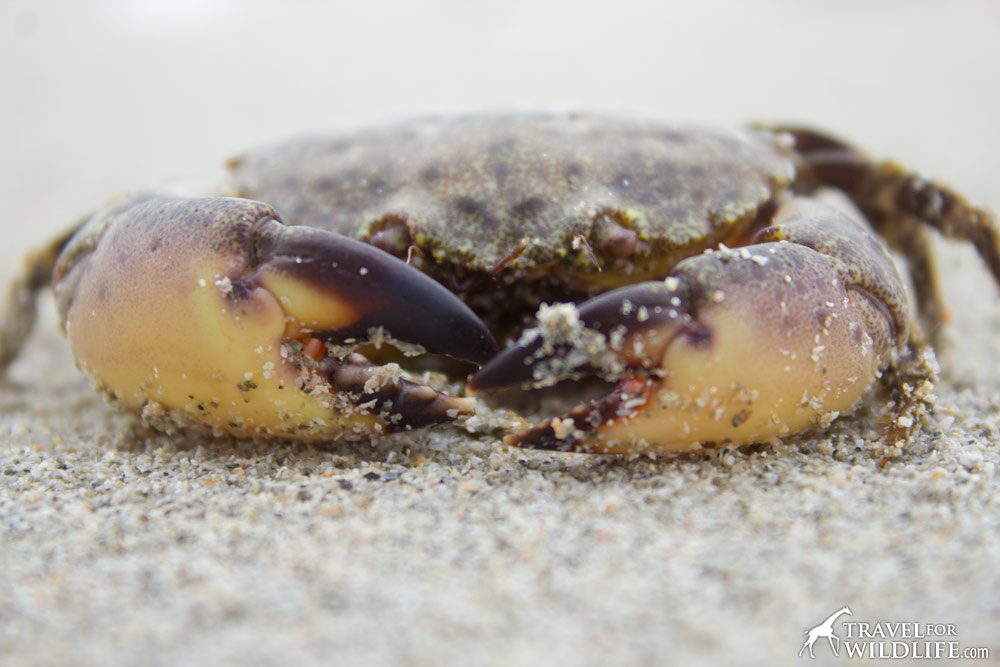
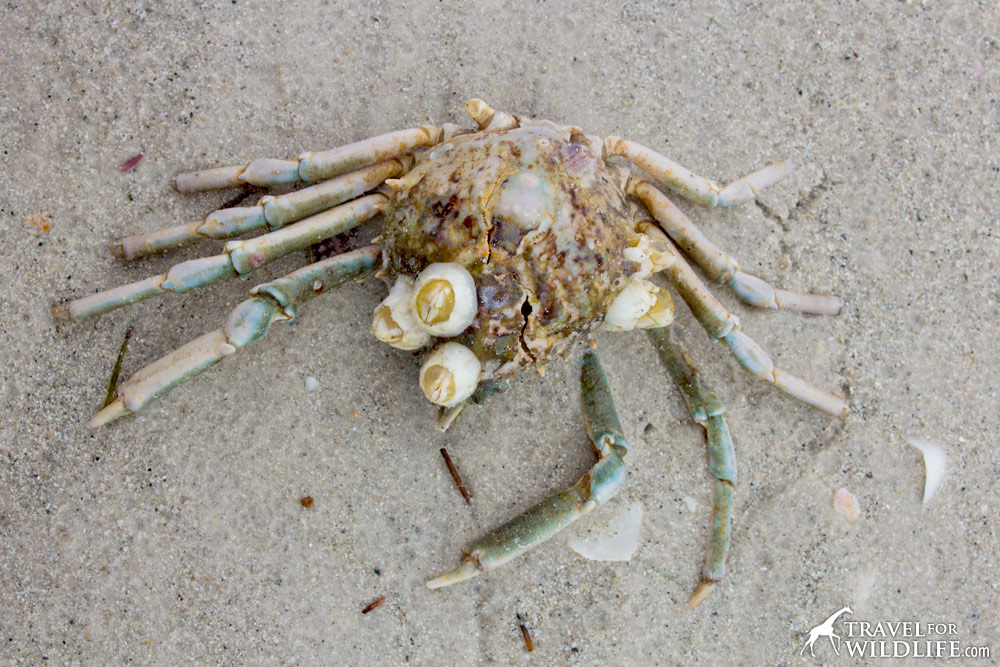
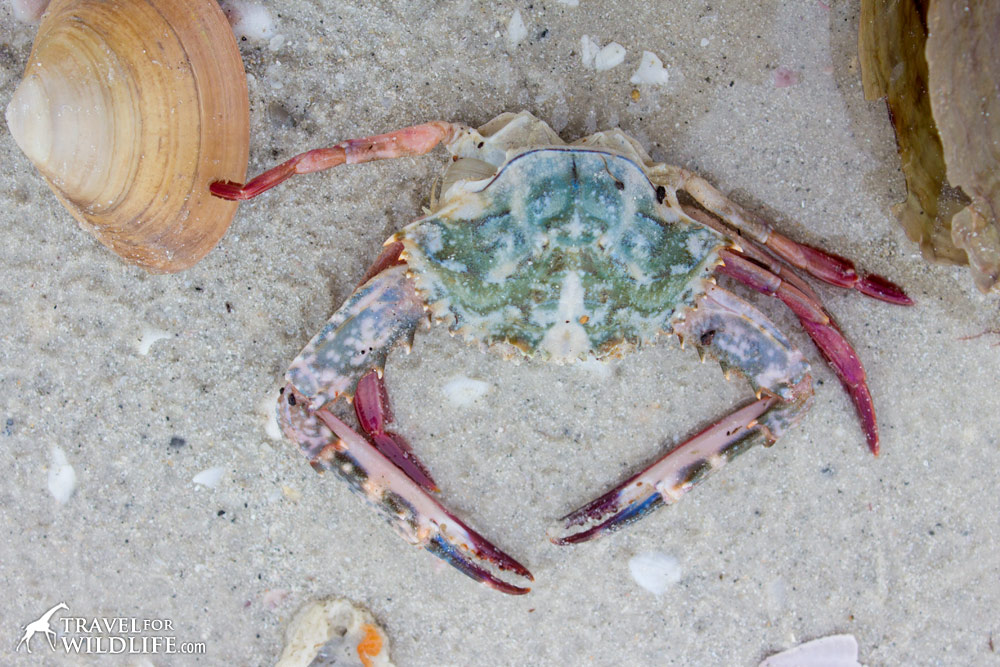
This last crab is not technically a crab at all. The Horseshoe Crab. It is actually more closely related to arachnids. When I first found it, it was lying on its back and slow waving its many legs in the air. It may have been flipped over by a wave.
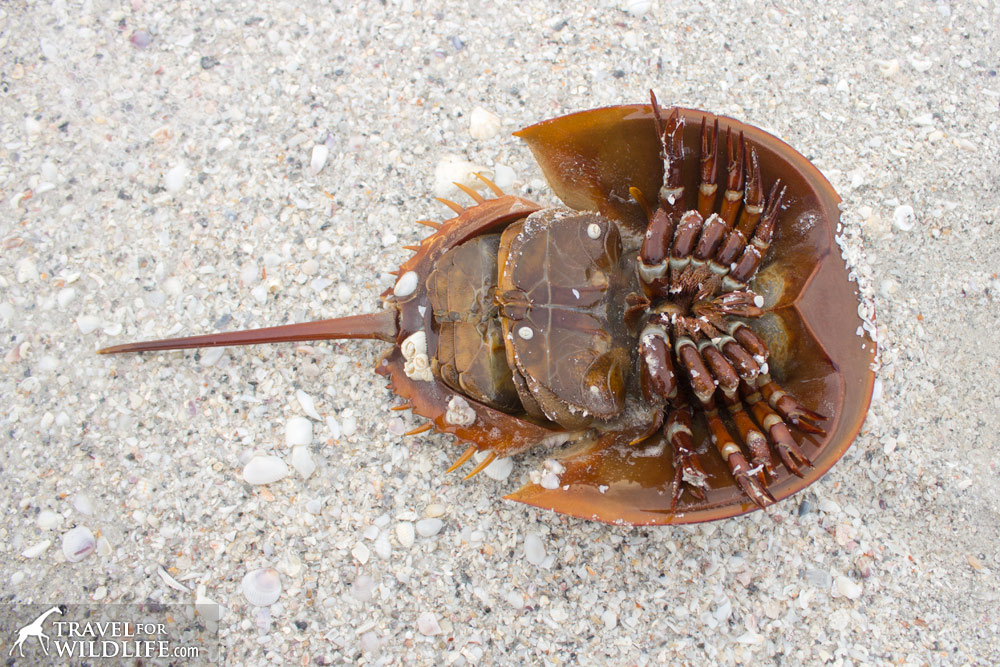
I carefully turned it over and watched it make its way back into the ocean.
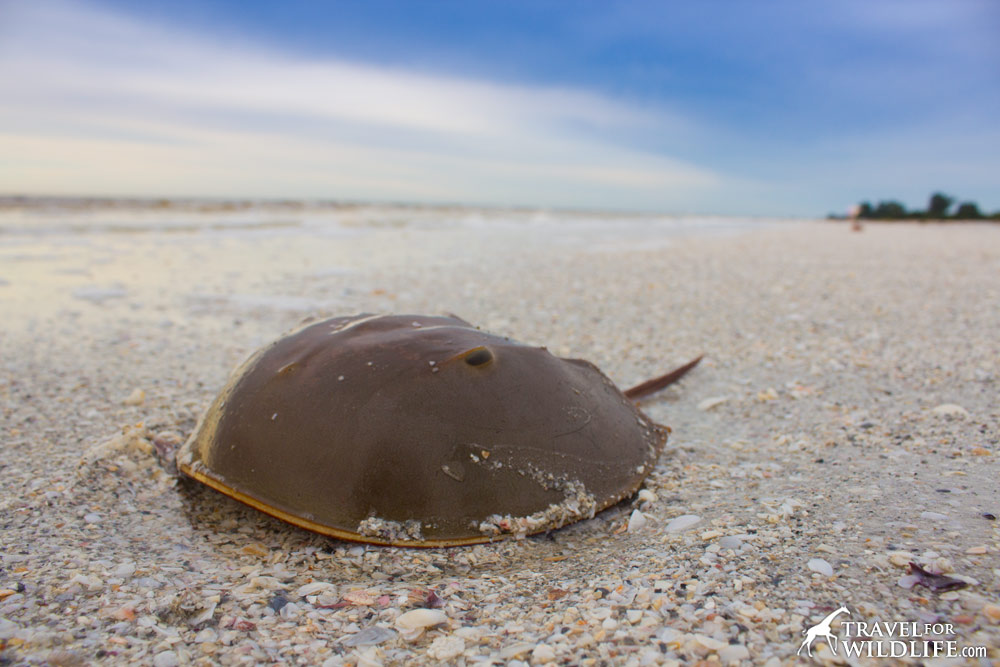
The right way to turn over a horseshoe crab is to flip it over from the side, not by the tail. The tail is used in navigation and is their only means of attempting to flip themselves over so it’s best to not risk injuring it!
Other Cool Seashore Creatures Found on Sanibel Island
There were dozens of other species, both alive and dead, covering the beach. Here are just a few of the fascinating seashore creatures I discovered.
This is a Nine-Armed Sea Star that I found upside down on the beach. You can see it is in the process of regenerating one of its missing arms.
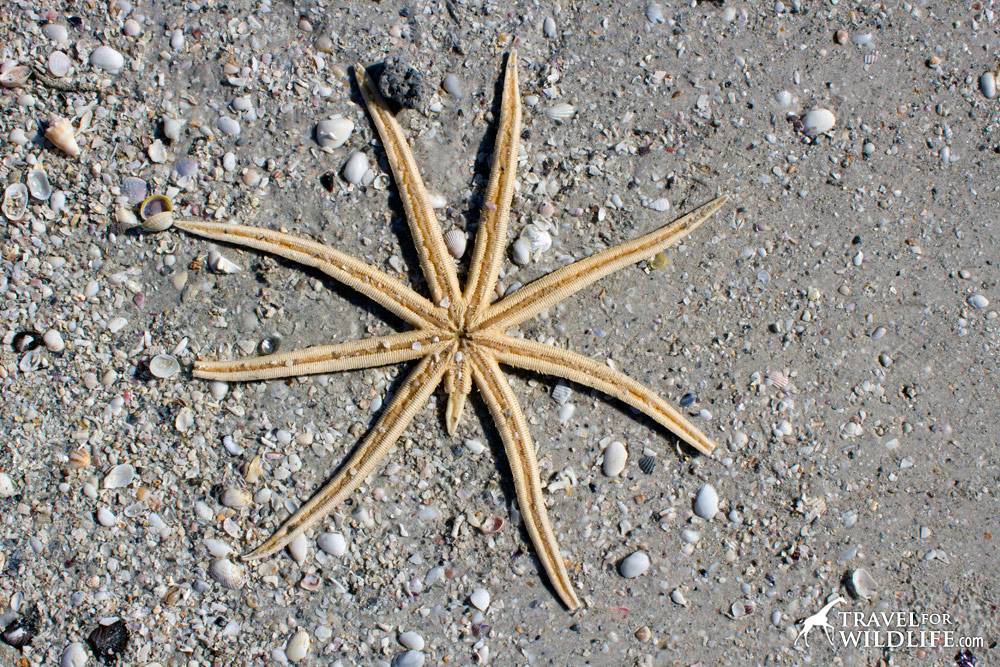
There were a bunch of other sea star species but my favorites were the beautiful little Brittle Sea Stars I found.
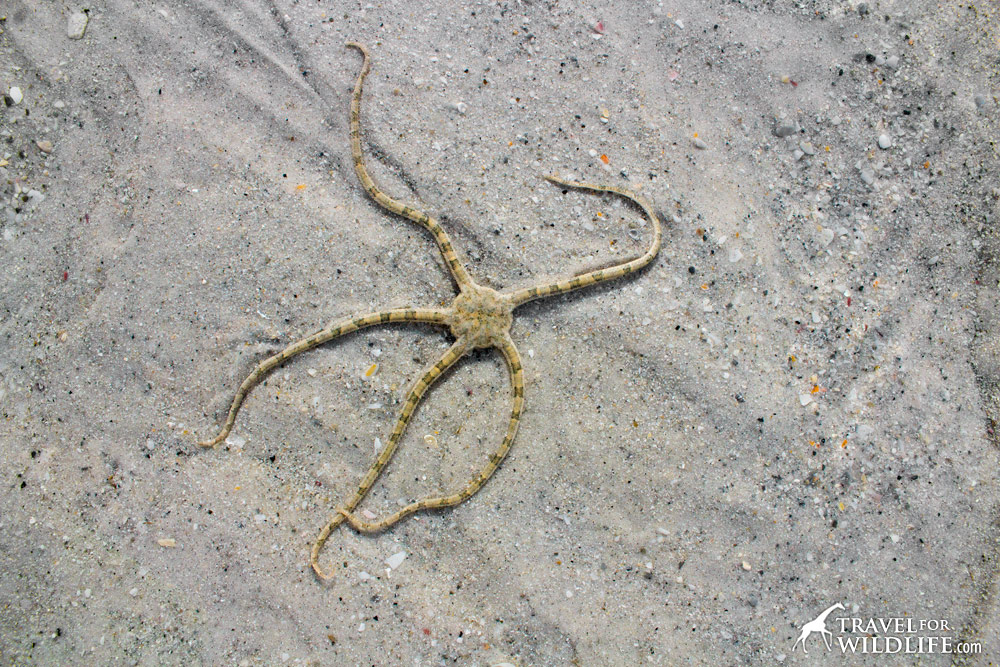
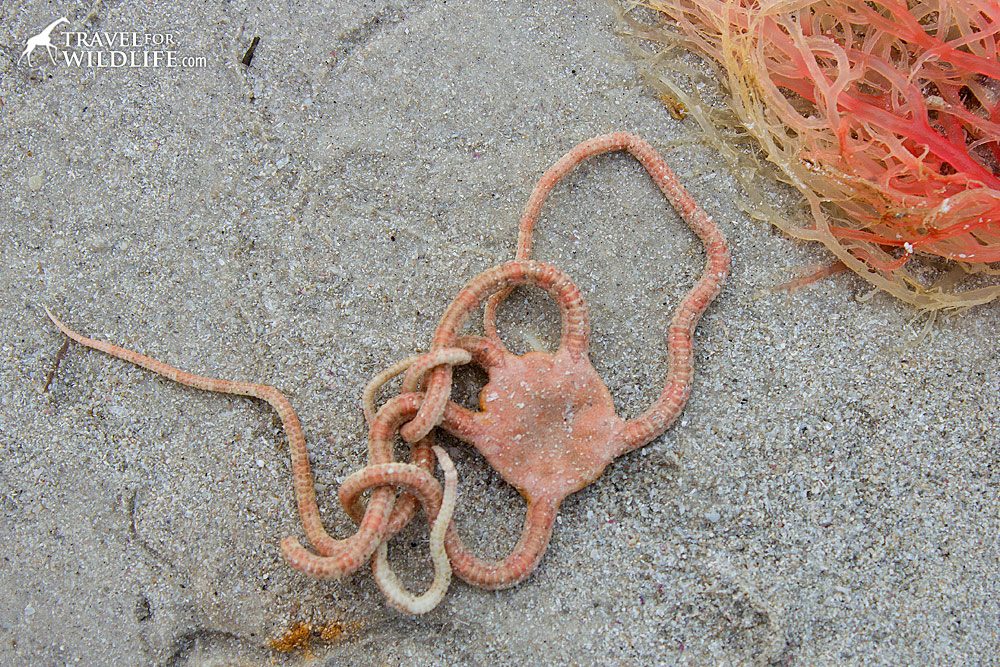
Here’s a crazy photo of the arm of sea star that had been bitten off to reveal some of the inner starfish anatomy, the digestive glands and the ampulla that inflate the tube feet.
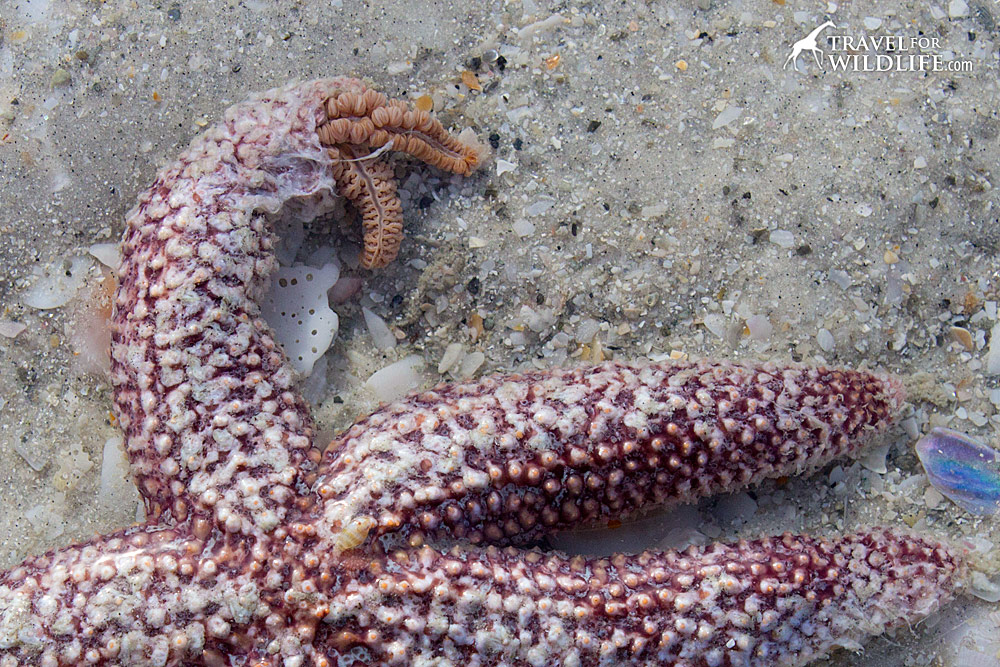
Here’s an amazing Mantis Shrimp that I found alive in a tide pool and returned to the ocean.
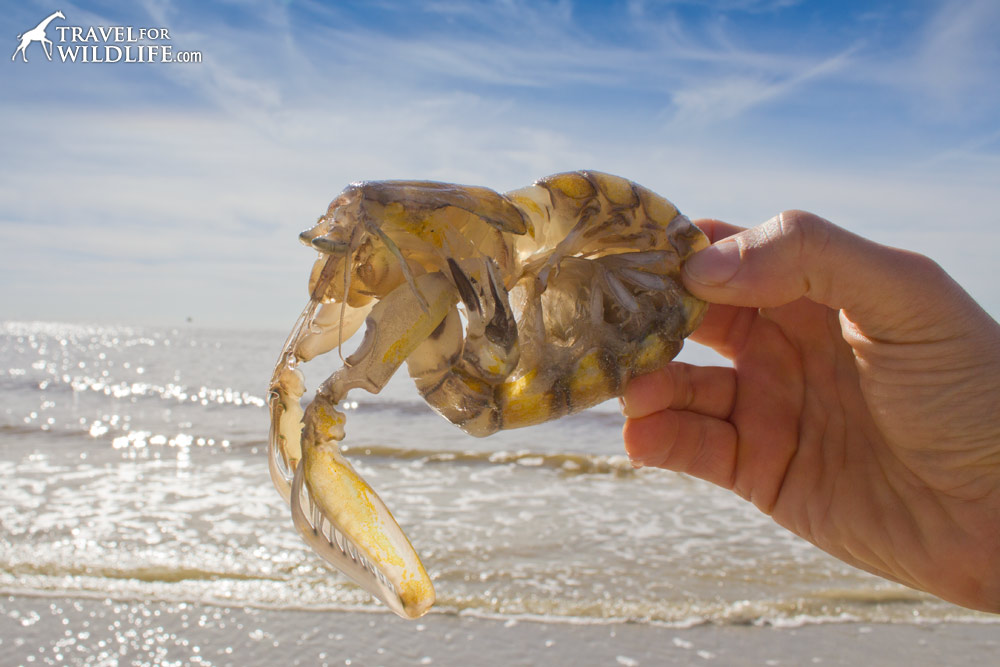
Even the worms were cool. This is a tube worm that uses bits of shell to create a protective tube around itself.
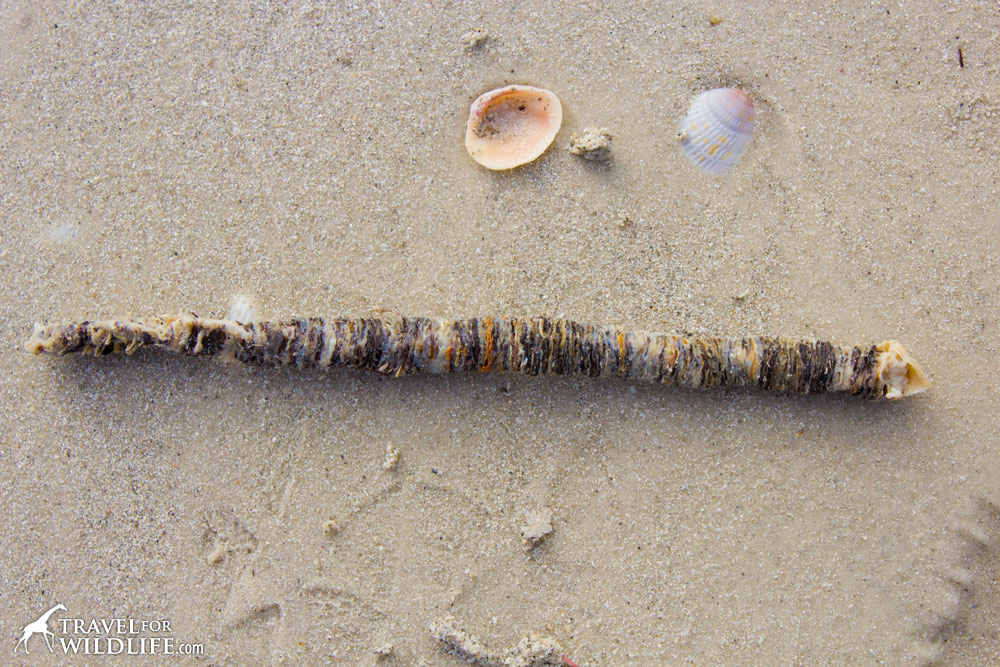
This one is known as a Peanut Worm. The first has its proboscis out and the second Peanut Worm has its proboscis in.
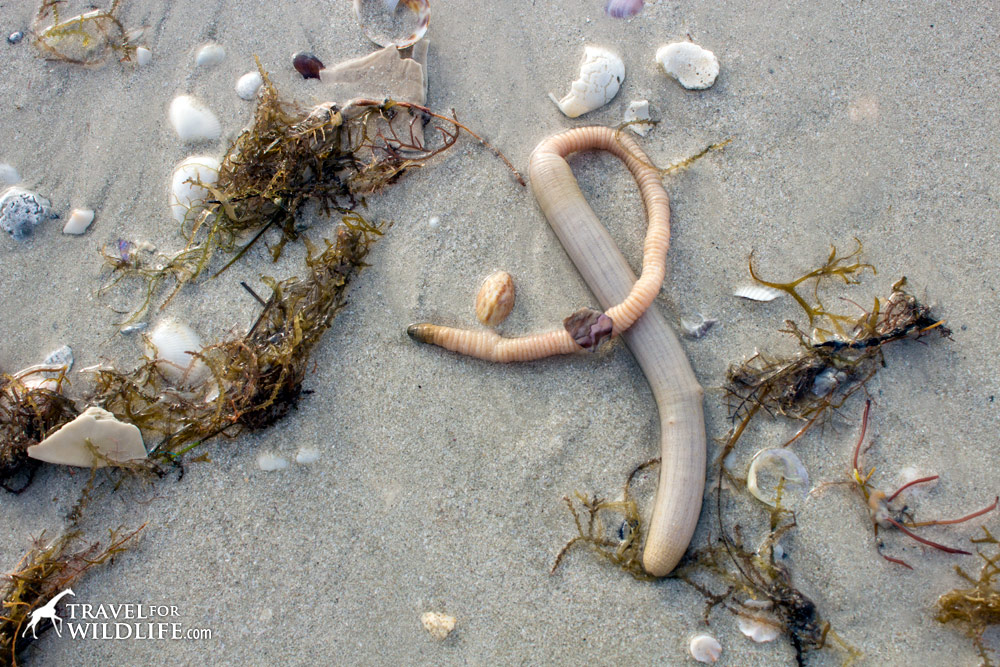
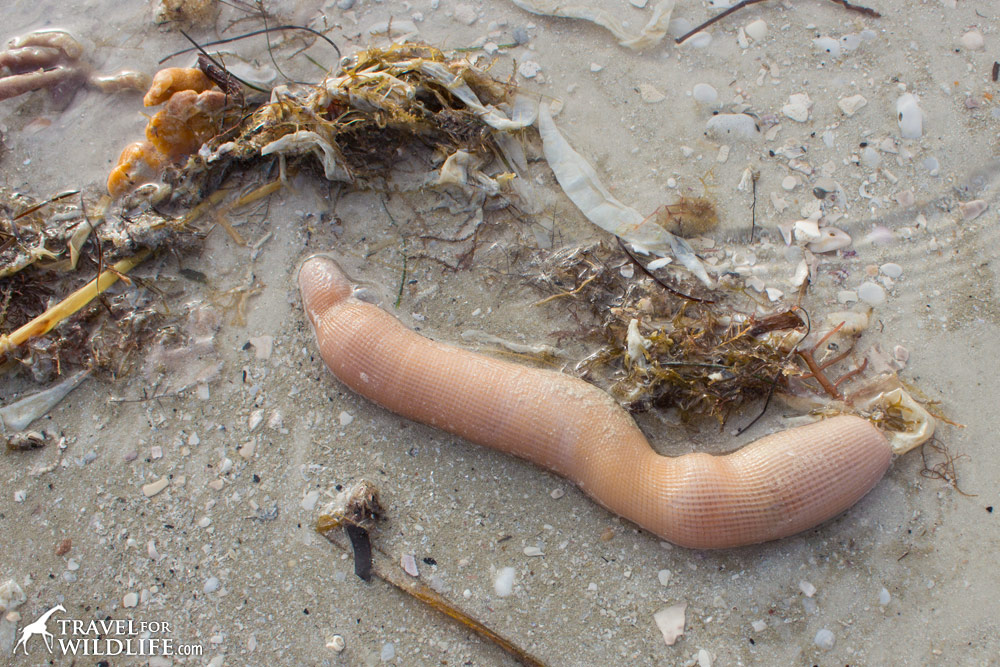
Some other cool creepy crawly critters included huge Sea Cucumbers…
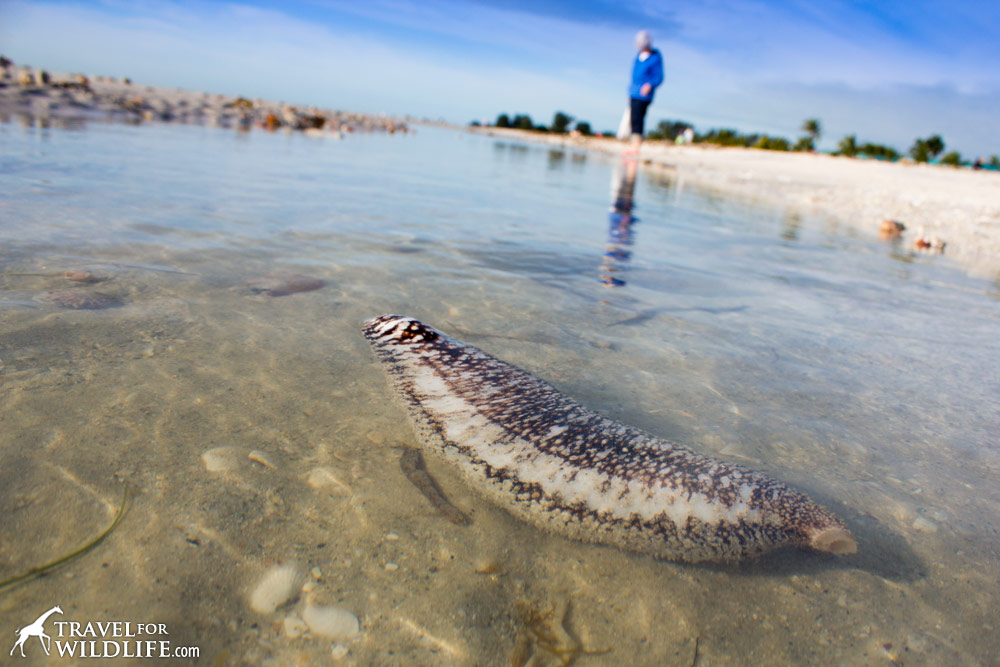
these weird orange blobs known as Sea Pork…
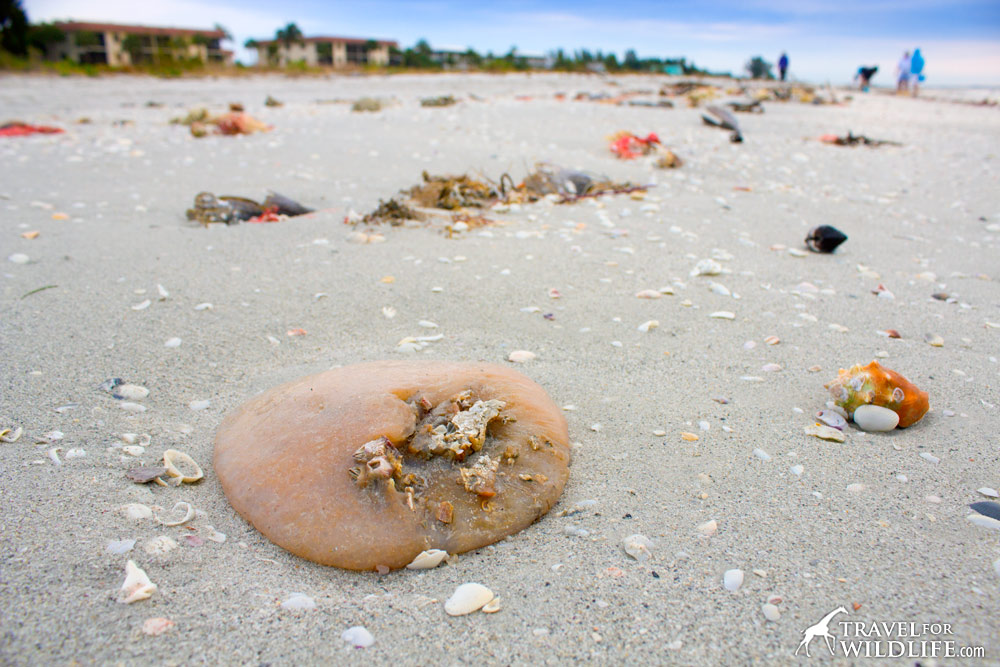
Sea Pork is actually a colony of tiny animals called tunicates.
There were beautiful pieces of red whip coral known as “Sea Whips”.
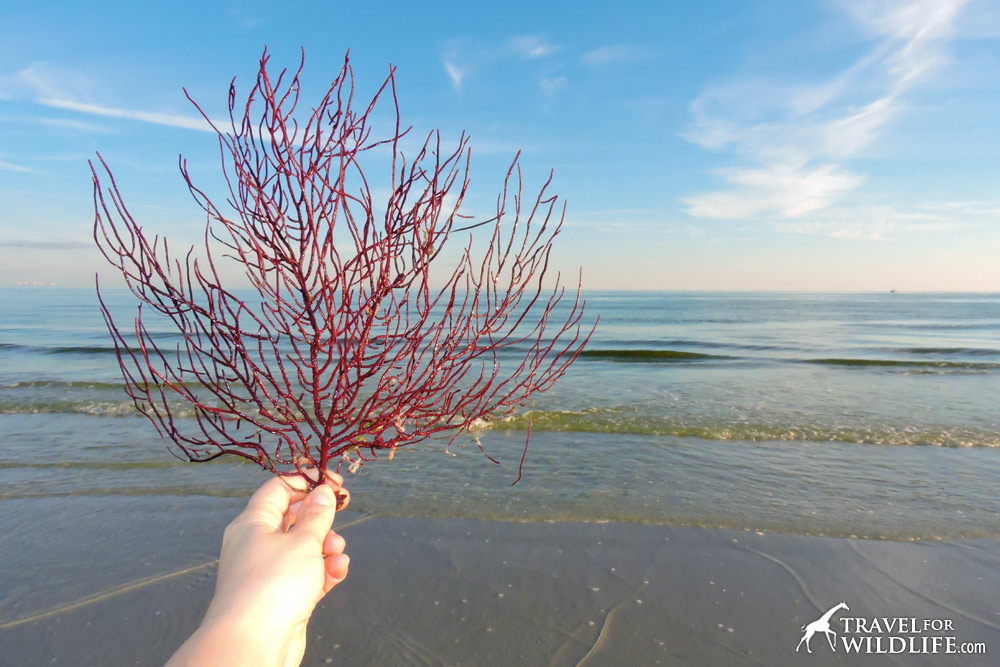
thousands of beautiful urchin shells…
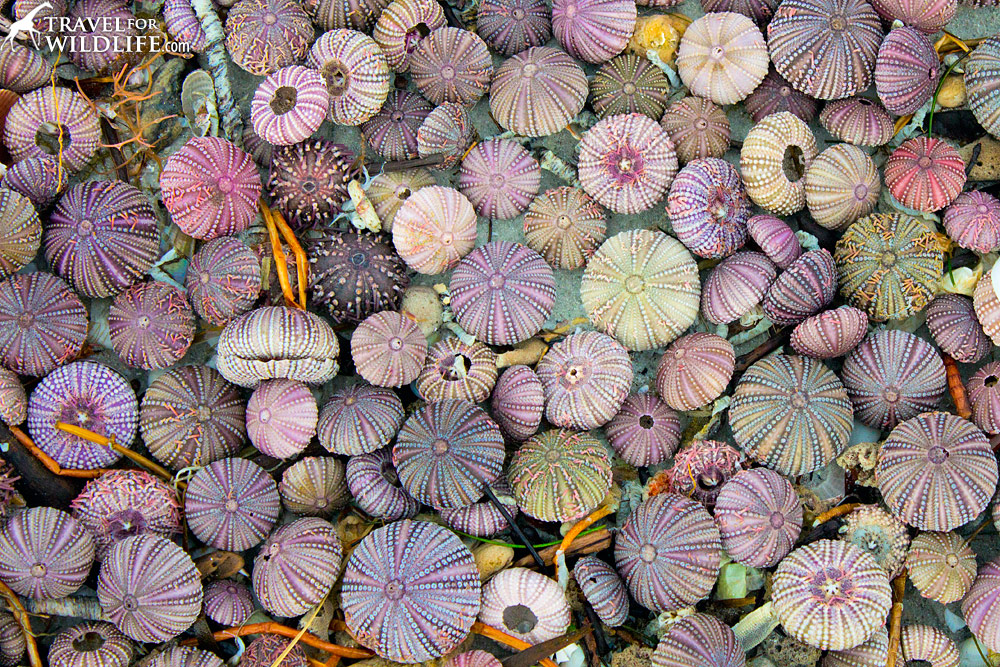
(By the way, we got so many requests for this crazy photo of sea urchin shells that you can now buy this sea urchin print on Fine Art America! Big canvas prints look especially nice!)
various anemones…
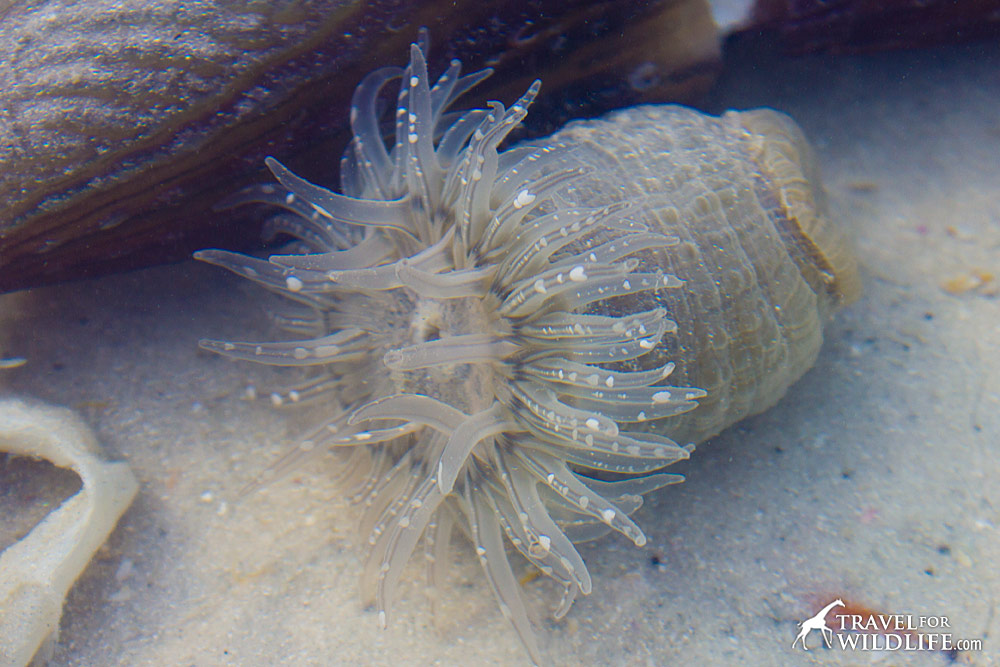
living sand dollars…
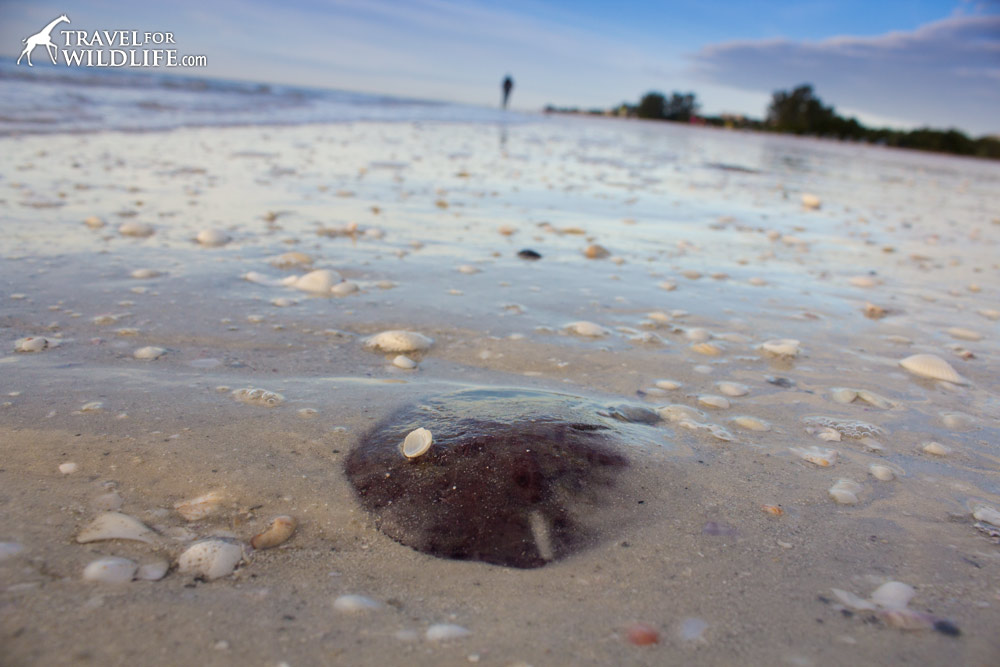
and my big prize was this bizarre creature which, as best I can tell, is some kind of bristle worm or fire worm. It was foraging through the tide pools and moved gracefully and delicately.
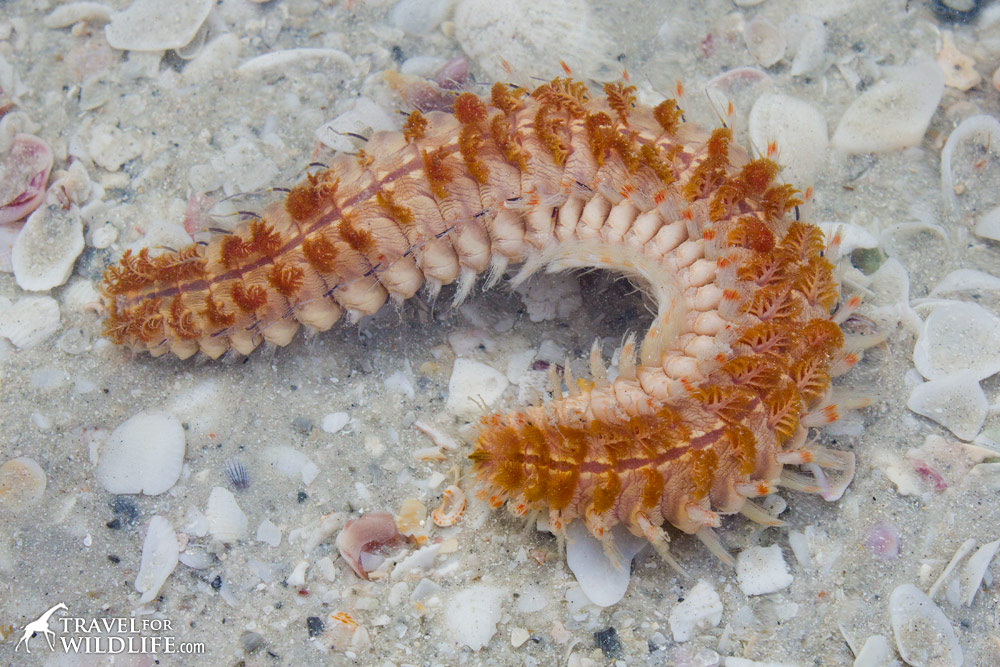
It was bit sad to see the thousands of fish that were killed by the red tide (more correctly termed a harmful algal bloom) and washed up on the beach. But it did allow me to see a few strange species that I haven’t managed to identify.
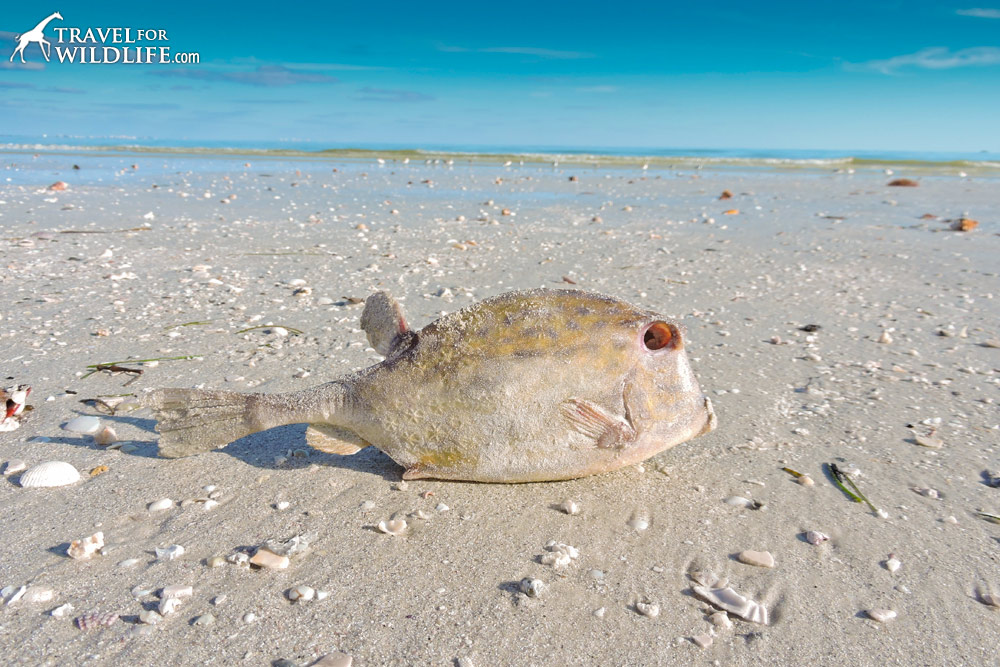
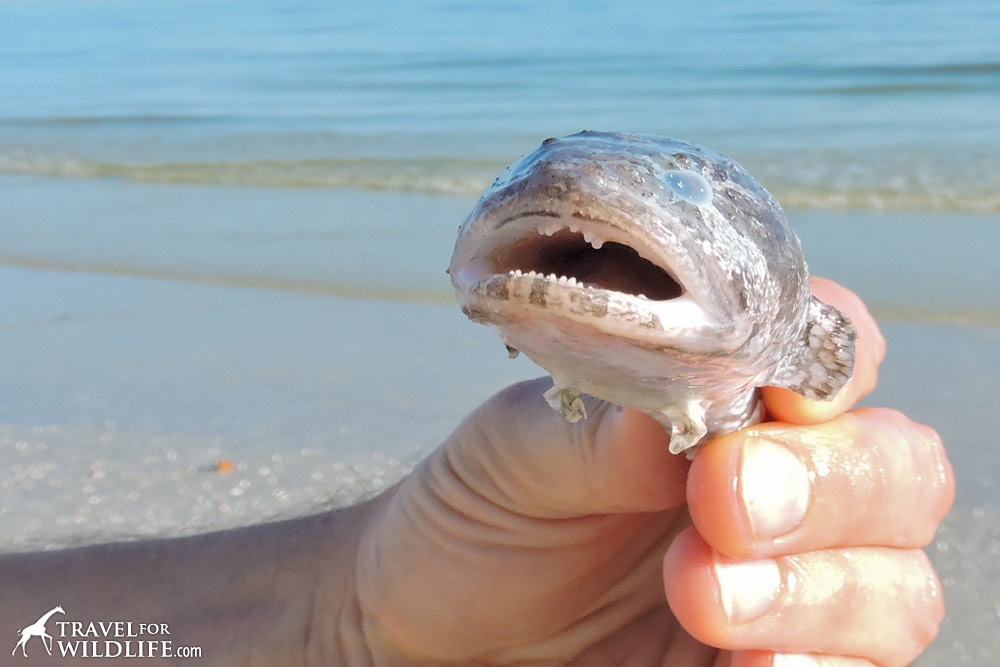
And this fish, the weirdest of all, appeared to be some kind of eel.
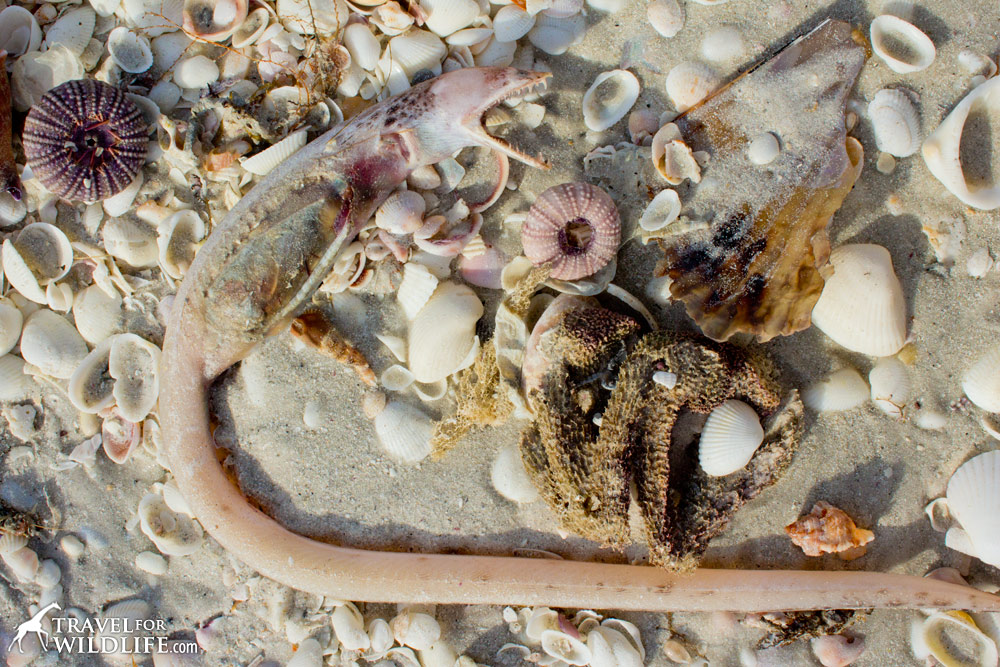
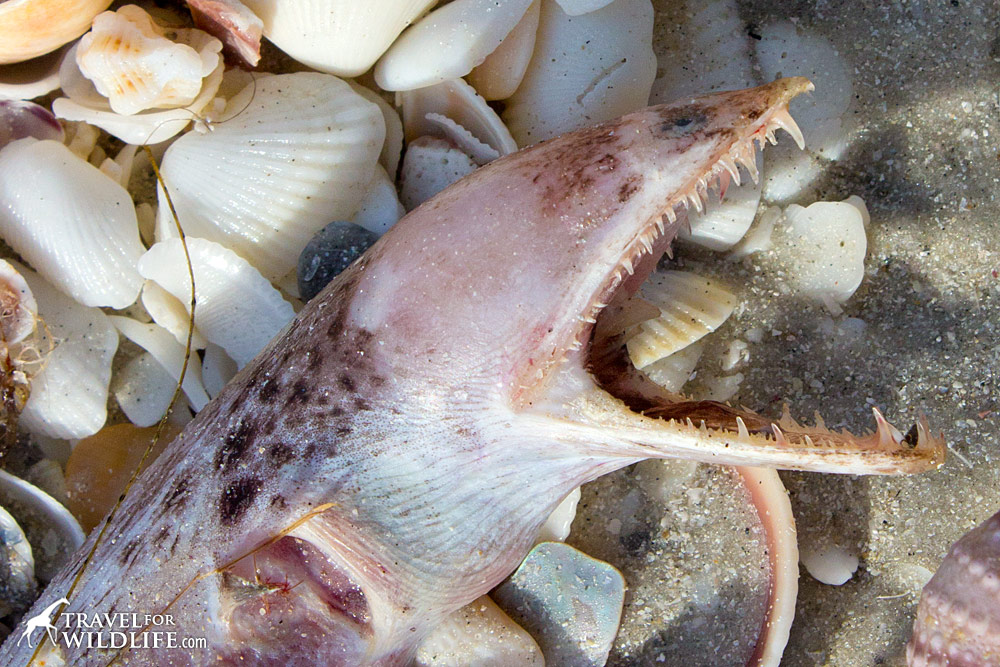
All in all, it was a fascinating and educational week in Sanibel and I highly recommend a visit. I hope you enjoyed my virtual shell collection!
READ THIS NEXT:
If you want to learn more about shelling on Sanibel Island, please check out our Guide to Ethical Shell Collecting.
Enjoy the photo gallery? Pin this image!
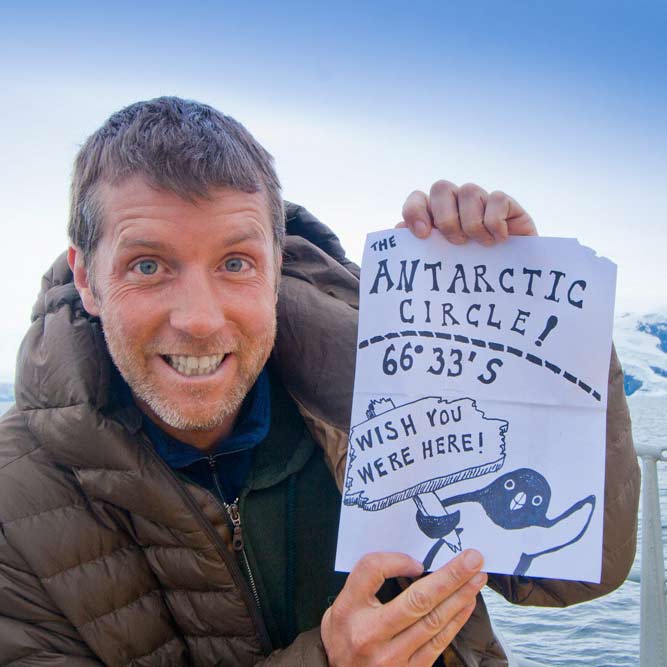
Hal Brindley
Brindley is an American conservation biologist, wildlife photographer, filmmaker, writer, and illustrator living in Asheville, NC. He studied black-footed cats in Namibia for his master’s research, has traveled to all seven continents, and loves native plant gardening. See more of his work at Travel for Wildlife, Truly Wild, Our Wild Yard, & Naturalist Studio.

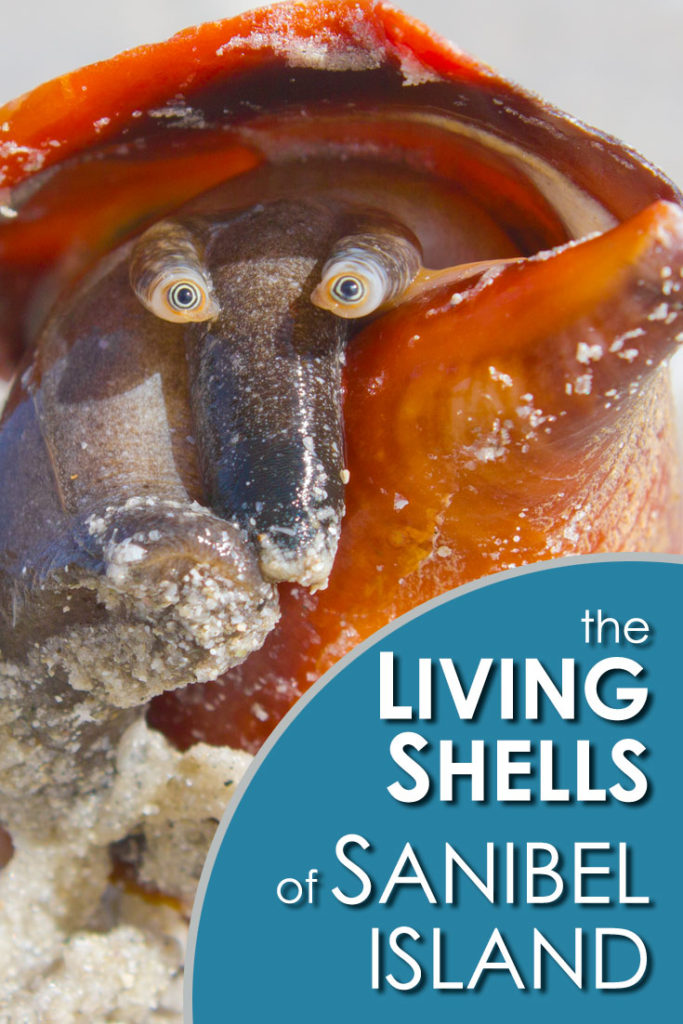
Chris
Friday 12th of January 2024
The "Florida Cone" that had a hermit crab in it was actually a juvenile Florida Fighting Conch shell.
Hal Brindley
Sunday 14th of January 2024
Great catch Chris! Thank you so much! I've updated the post. -Hal
Ryan
Tuesday 6th of April 2021
On vacation in FL right now and was blown away by all the shells in the beach. So I was surfing the internet and came across this. Very cool! I learned a lot here! Thank you for what you do!!
David
Friday 13th of September 2019
Wonderful and informative photo gallery. Great source for the drawings and paintings I want to do of the living mollusks within their shells. Watch the grammar though. When you abbreviate something like "It is best to flip it from its side, not the tail..." the proper abbreviation for "it is" is "it's," not "its." The contraction "its" is for the possessive form of "it." Very informative commentary anyway. Thank you for your photos and comments.
Sage
Monday 22nd of July 2019
Those pretty looking sea urchins are purple sea urchins
Lauren
Monday 30th of April 2018
I very much enjoyed reading your article except why be biased and say 'evil' eel at the end instead of using the correct name like any other sea creature on this article. I enjoyed looking at the pictures otherwise.
Hal Brindley
Monday 30th of April 2018
Hi Lauren, you make a valid point. I should have said "scary-looking" because, you have to admit, it would make an awesome monster in a really scary movie. I assure you I don't think eels are evil (or any animal for that matter) and I definitely don't want to bias any other readers into thinking that so I'll change it. However, I'm willing to bet you are actually biased TOWARD eels because you have "moray" in your email address, so do you happen to know what species this is? Because I can't find it anywhere! Thanks for reading, -Hal